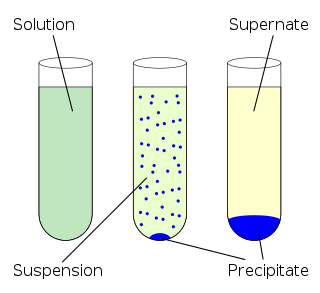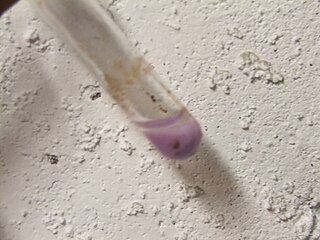
Hydroxide is a diatomic anion with chemical formula OH−. It consists of an oxygen and hydrogen atom held together by a single covalent bond, and carries a negative electric charge. It is an important but usually minor constituent of water. It functions as a base, a ligand, a nucleophile, and a catalyst. The hydroxide ion forms salts, some of which dissociate in aqueous solution, liberating solvated hydroxide ions. Sodium hydroxide is a multi-million-ton per annum commodity chemical. A hydroxide attached to a strongly electropositive center may itself ionize, liberating a hydrogen cation (H+), making the parent compound an acid.

In chemistry, there are three definitions in common use of the word base, known as Arrhenius bases, Brønsted bases and Lewis bases. All definitions agree that bases are substances which react with acids as originally proposed by G.-F. Rouelle in the mid-18th century.

Potassium hydroxide is an inorganic compound with the formula KOH, and is commonly called caustic potash.

Precipitation is the process of transforming a dissolved chemical substance into an insoluble solid from a super-saturated solution. When the reaction occurs in a liquid solution, the solid formed is called the precipitate. In case of a chemical reaction leading to precipitation, the chemical reagent causing the solid to form is called the precipitant.

Calcium hydroxide (traditionally called slaked lime) is an inorganic compound with the chemical formula Ca(OH)2. It is a colorless crystal or white powder and is produced when quicklime (calcium oxide) is mixed or slaked with water. It has many names including hydrated lime, caustic lime, builders' lime, slack lime, cal, and pickling lime. Calcium hydroxide is used in many applications, including food preparation, where it has been identified as E number E526. Limewater is the common name for a saturated solution of calcium hydroxide.

Deprotonation (or dehydronation) is the removal (transfer) of a proton (or hydron, or hydrogen cation), (H+) from a Brønsted–Lowry acid in an acid–base reaction. The species formed is the conjugate base of that acid. The complementary process, when a proton is added (transferred) to a Brønsted–Lowry base, is protonation (or hydronation). The species formed is the conjugate acid of that base.
Dichlorocarbene is the reactive intermediate with chemical formula CCl2. Although this chemical species has not been isolated, it is a common intermediate in organic chemistry, being generated from chloroform. This bent diamagnetic molecule rapidly inserts into other bonds.

Tin(II) hydroxide, Sn(OH)2, also known as stannous hydroxide, is an inorganic compound tin(II). The only related material for which definitive information is available is the oxy hydroxide Sn6O4(OH)4, but other related materials are claimed. They are all white solids that are insoluble in water.
Lead(II) hydroxide, Pb(OH)2, is a hydroxide of lead, with lead in oxidation state +2. In 1964 it was believed that such a simple compound did not exist as Lead basic carbonate (PbCO3·2Pb(OH)2) or lead(II) oxide (PbO) was encountered where lead hydroxide was expected. This has been a subject of considerable confusion in the past. However, subsequent research has demonstrated that lead(II) hydroxide does indeed exist as one of a series of lead hydroxides.

The Reimer–Tiemann reaction is a chemical reaction used for the ortho-formylation of phenols; with the simplest example being the conversion of phenol to salicylaldehyde. The reaction was discovered by Karl Reimer and Ferdinand Tiemann. The Reimer in question was Karl Reimer (1845-1883) not the less known Carl Ludwig Reimer (1856-1921).

Uranyl hydroxide is a hydroxide of uranium with the chemical formula UO2(OH)2 in the monomeric form and (UO2)2(OH)4 in the dimeric; both forms may exist in normal aqueous media. Uranyl hydroxide hydrate is precipitated as a colloidal yellowcake from oxidized uranium liquors near neutral pH.

Tetramethylammonium hydroxide (TMAH or TMAOH) is a quaternary ammonium salt with the molecular formula N(CH3)4+ OH−. It is commonly encountered as concentrated solutions in water or methanol. The solid and solutions are colorless, or yellowish if impure. Although TMAH has virtually no odor when pure, samples often have a strongly fishy smell from the trimethylamine which is a common impurity. TMAH has numerous and diverse industrial and research applications.
The carbylamine reaction is the synthesis of an isocyanide by the reaction of a primary amine, chloroform, and base. The conversion involves the intermediacy of dichlorocarbene.
Aluminium hydroxide oxide or aluminium oxyhydroxide, AlO(OH) is found as one of two well defined crystalline phases, which are also known as the minerals boehmite and diaspore. The minerals are important constituents of the aluminium ore, bauxite.
The proton affinity of an anion is a neutral atom or molecule is the negative of the enthalpy change in the reaction between above species and proton in the gas phase:

Tetrabutylammonium bromide (TBAB) is a quaternary ammonium salt with a bromide commonly used as a phase transfer catalyst. It is used to prepare many other tetrabutylammonium salts by salt metathesis reactions. The anhydrous form is a white solid.
tert-Butyl isocyanide is an organic compound with the formula Me3CNC (Me = methyl, CH3). It is an isocyanide, commonly called isonitrile or carbylamine, as defined by the functional group C≡N-R. tert-Butyl isocyanide, like most alkyl isocyanides, is a reactive colorless liquid with an extremely unpleasant odor. It forms stable complexes with transition metals and can insert into metal-carbon bonds.

Cobalt(II) hydroxide or cobaltous hydroxide is the inorganic compound with the formula Co(OH)
2, consisting of divalent cobalt cations Co2+
and hydroxide anions HO−
. The pure compound, often called the "beta form" is a pink solid insoluble in water.

Benzyltrimethylammonium hydroxide, also known as Triton B or trimethylbenzylammonium hydroxide, is a quaternary ammonium salt that functions as an organic base. It is usually handled as a solution in water or methanol. The compound is colourless, although the solutions often appear yellowish. Commercial samples often have a distinctive fish-like odour, presumably due to the presence of trimethylamine via hydrolysis.
Calcium nitrite is an inorganic compound with the chemical formula Ca(NO
2)
2. In this compound, as in all nitrites, nitrogen is in a +3 oxidation state. It has many applications such as antifreeze, rust inhibitor of steel and wash heavy oil.













